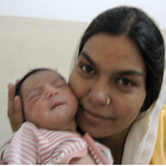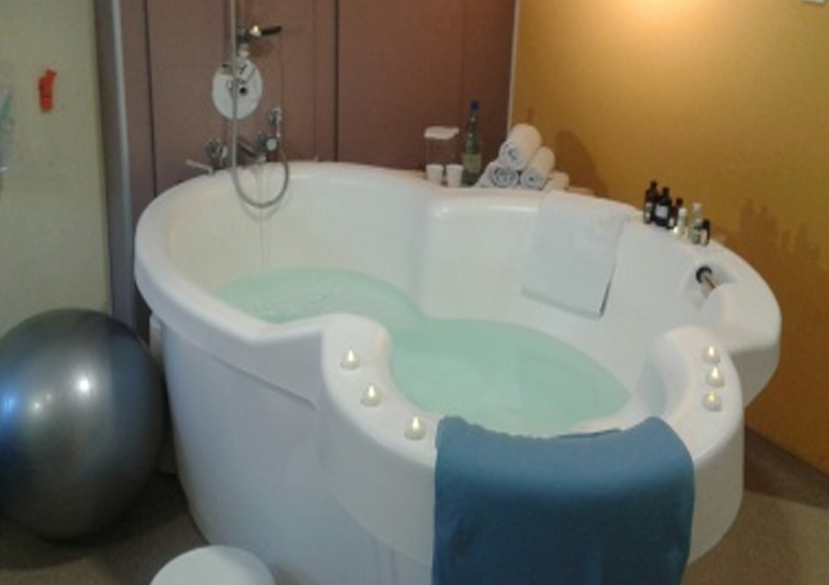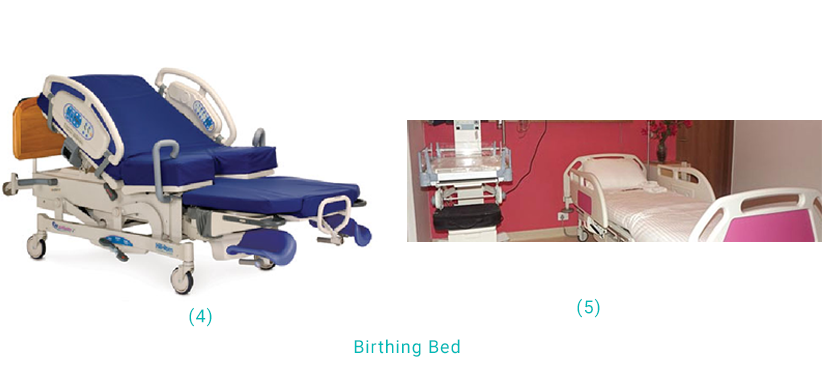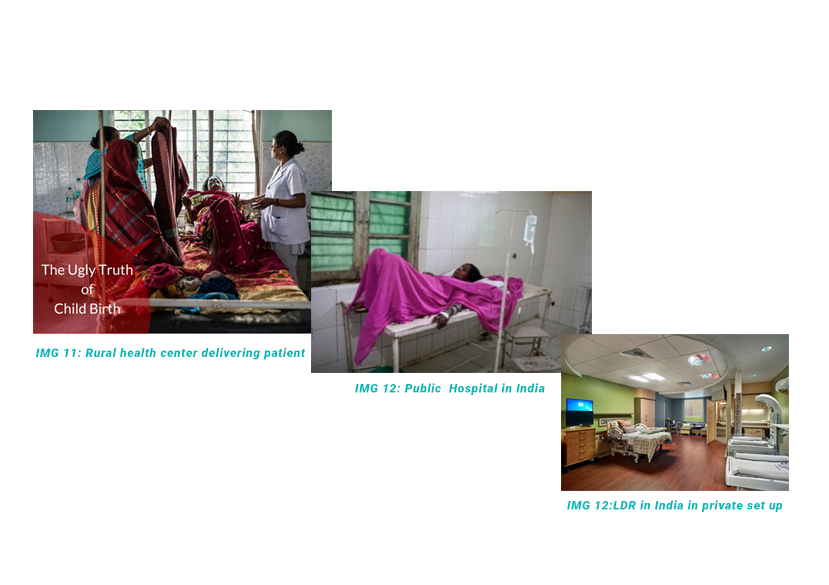BIRTHING SUITE -LABOUR DELIVERY RECOVERY ROOM

Dr.Maninder Ahuja
Director Ahuja Health Services
Faridabad

Mother and Child Dyad
Winston Churchill did say that ” We shape our building and the building shape us…” Kleeman in his book The challenge of Interior Design states, “ there are those who assert that essentially the design of an interior space and its location not only can communicate with those who enter it but also controls their behaviour”
BACK GROUND AND HISTORY OF BIRTHING
Traditionally child birth had been taking place in homes only with the help of elderly ladies and mid wifeMen were just onlookers !
To make deliveries safe for mothers and because of advent of antibiotics and blood and trained medical persons ,field of action changed to hospital deliveries in twentieth century.
But in this process “labour became lonely”
Medical historian Judy Leavitt, a professor emeritus at the University of Wisconsin-Madison, traces the history of fathers and childbirth in her book "Make Room for Daddy: The Journey from Waiting Room to Birthing Room- wrote :,"The nurses are busy, going in and out, and the laboring women are laboring on their own. And they don't like it."
In sixties in institutional deliveries father just got a glimpse of babies just through a window as newborns were kept in nurseries. Children and other family members at home felt left out of whole excitement of welcoming new member to the family.” This an extract from a write up in 1988 by Aletha Anderson, a free-lance writer from North Tustin who gave birth to her first child in December1987.
"There was a dehumanizing of the birth process" that isolated fathers and siblings from mother and newborn.
"Outcries to humanize the birth process" led to the popularity of home births and alternative birthing centers within hospitals and to the participation of fathers and families in the birth process and it has become a family experience. In fact, in the 1960s, only nursery room nurses could touch the baby and even new mothers in the hospital were "not to unwrap or touch the baby,given to them in pillow cases"
But drastic changes came in understanding of bonding of mother and child so it became important to have first skin to skin contact of mother and new born immediately after birth of baby.
As this helps the baby adapt to life outside the mother's body. Newborn stress levels are reduced, the heart and respiratory rate stabilizes, glucose levels increase, temperature increases and the newborn starts to move toward the breast to feed. Mothers also have decreased stress and pain levels as they begin to get to know and nurture their newborn.
Instead of nursery care concept of” rooming in” became popular.
INTRODUCTION
Birthing suite/LDR room concept is "not designed to change medical practice"--physicians can give the same care as in a traditional setting,but there is dramatic change in nursing care and in the decision making right with the woman. It is nursing care which is more personal and one to one.
Change of Beds in a normal delivery Process in Labour delivery wards: In a normal hospital setting for conventional non complicated delivery in labour wards , usaul proces is that the woman who enters the hospital in the early stages of labor is put into a semi-private labor room along with her attendant , who is usually the baby's father or in India mother in law./ Or patient is in a general labour ward with no privacy, When birth is imminent, the the woman is wheeled into the delivery room, shortly after the baby is born, the mother is wheeled again, this time to a recovery room, where she is moved onto a new bed ,so another change of bed and the baby is whisked off to the nursery, often with the father in attendance, to be checked over by the nursery staff.After one to two hours in recovery, the mother is transferred once more, this time to her postpartum room, where she'll stay until she's discharged from the hospital. There, in her fourth bed and room, she and the coach can relax with the baby and be joined by the rest of the immediate family.
"To be moved around like that is very disruptive"Getting up and moving when you're in pain is most difficult thing to do."
Why we need Special LDR rooms ?
Birthing suites /LDR rooms are just labour,delivery and recovery rooms with family or birth partner and your Midwife and obstetrician with all facilities for delivery and baby care in the same room.These are woman friendly services.
-
Women in labor have specific physical, emotional, and mental needs in
order
to master
the ability to relax completely as a pain relief tool.(1)
A British survey in 2005 further itemized the environmental needs that
women
rated as important in labor.
- A clean room
- Being able to stay in the same room throughout labor
- Being able to walk around.
- Most women also wanted the use of an en suite toilet
- A comfortable chair for their birth partner.
- More than 50 percent of women said that having a birth pool available was at least moderately important, and 30 percent said that it was of high importance.
-
COST OF SHIFTING PATIENTS :
- To transfer a patient from one room to other involves cost any way between $30 to $90 when the nurse's time, linens, time spent remaking and cleaning a bed and the cost of keeping several rooms heated and lighted are accounted for.
- Space is one consideration why all hospitals can’t have LDR Rooms All these need architectural designing so that maximum utilisation of space can be done.
- The number of babies delivered each year by a hospital also plays a role. Based on an average maternity stay, the LDRP room can handle a maximum of 100 births a year.
- But saving is there as new borns don’t need nursery transfer and can stay with mother and that space and staff and equipment can be saved.
-
PAIN RELIEF :
Main need of women is pain relief during labour Most of the hospital now give epidural analgesia but that has its own side effects and so many women would like to avoid it and would love to have a non pharmacological management of pain . Towards pain relief therapies which can be provided in a birthing suite or LDR are birthing in water, relaxing atmosphere, space to move about and privacy to take various postures , support of birthing partner ,aroma therapies, light control ,music of choice. Evidence about birthing in water is supportive about first stage immersion in water but not much favourable for second stage of labour. Some of the points of (3)ACOG Committee opinion Number 679, November 2016 about birthing in water are :- Immersion in water during the first stage of labor may be associated with shorter labor and decreased use of spinal and epidural analgesia and may be offered to healthy women with uncomplicated pregnancies between 37 0/7 weeks and 41 6/7 weeks of gestation.( FIG:1)
- There are insufficient data on which to draw conclusions regarding the relative benefits and risks of immersion in water during the second stage of labor and delivery. Therefore, until such data are available, it is the recommendation of the College that birth occur on land, not in water.
- A woman who requests to give birth while submerged in water should be informed that the maternal and perinatal benefits and risks of this choice have not been studied sufficiently to either support or discourage her request. She also should be informed of the rare but serious neonatal complications associated with this choice.
- The opinions expressed in this document should not be interpreted in such a manner as to prevent the conduct of well-designed prospective studies of the maternal and perinatal benefits and risks associated with immersion during labor and delivery.
- Facilities that plan to offer immersion during labor and delivery need to establish rigorous protocols for candidate selection; maintenance and cleaning of tubs and pools; infection control procedures, including standard precautions and personal protective equipment for health care personnel; monitoring of women and fetuses at appropriate intervals while immersed; and moving women from tubs if urgent maternal or fetal concerns or complications develop.(IMG:2)

In the United Kingdom recently reported rates of immersion range from 1.5% of hospital deliveries to 58% of births in a free standing midwifery unit (4,5). Several professional organizations, including the Royal College of Obstetricians and Gynaecologists and the American College of Nurse–Midwives, support healthy women with uncomplicated pregnancies laboring and giving birth in water (6,7). The United Kingdom’s National Institute for Health and Care Excellence states that women should be informed that there is insufficient high-quality evidence to either support or discourage giving birth in water (8).

Concept of LDR Compared to Normal labor delivery ward:
The LDR and LDRP rooms are the latest step, providing a marriage of the home birthing idea with "all the benefits of the medical world," The concept "is a maturing of physicians and nurses to what the patients really want. It forces people to be a little more sensitive to the needs of the FAMILY."It is woman centred care.
REQUIREMENTS OF BIRTHING SUITE/LDR Room:
Birthing suites also called LDR and LDRP rooms are designed to have labour , delivery and postpartum care in the same room with the family.Some requirements of these rooms are :
-
Birthing bed: Redefining Motherhood-Live the Birth experience are
the
Labor
and delivery are beds ,which combine comfort and technology combined
tother
.They
break down in the middle to become birthing beds, complete with
stirrups,
handles,
and even a birthing bar (to hold onto as woman pushes.) on some models.
Post delivery,
they're whisked back together so that no change of bed requires and no
shifting of
patient from one bed to another bed .(IMG:4,5)

-
Medical equipment . All medical equipment is tucked away neatly
and
discreetly
in labor and deliver rooms .
- There are suction and oxygen receptacles hidden behind those pretty pictures on the walls, and some
- Nice wooden closets and doors hold the delivery table.
- Infant resuscitation equipment is there ready to be wheeled in at delivery or as necessary.
- In some labor and deliver rooms, with the flip of a switch a paneled ceiling may convert to reveal overheard lights and a birthing mirror.
- The fetal monitor. Along with patient’s bed, there is IV pole, and bloopressure equipment, a bedside fetal monitor. The fetal monitor also usually houses a computer where nurse will input vital medication information to keep track of your labor's progress.
- Neonatal resucitation trolley
- Baby Basinet to keep baby .
- The partner chair. LDR have a sofa which can be converted into a bed for birthing partner,Birthing partner or companions are recommended by many studies and Nice guidelines also.(1) We need place for them to sit and sleep in comfort.(IMG :5 Birthing
- The bathroom. En suite bathrooms are a must . There can be a shower chair can help you if patient does not feel comfortable in first shower; Some hospitals or birthing suites have tubs or Jacuzzi tubs for laboring mothers. There should be also be an emergency button or cord so that patient can activate should she needs assistance.
- Rooms should look like home, with decorative bedspreads, wooden
furniture
and framed
prints on the wall that conveniently hide medical equipment when it's
not
needed.(IMG6)

- The LDR approach also makes it easier for a mother and other family members to bond more quickly with the newborn, a process considered important to a baby's emotional well-being.
LDR Rooms in USA:
- These rooms are designed to accommodate the laboring woman
- Her medical attendants as well as the equipment.
- They do not provide adequate space or provisions for non-pharmacological
pain
relief techniques
like birth pool

-
LDR Rooms in UK:

- LDR rooms in England, even in large institutional teaching hospitals, often include a permanent birth pool that is accessible from three sides.
- These rooms are most of time smaller than and do not generally meet American code requirements for size.
- British maternity units are commonly staffed with midwives and doulas that are trained in non-pharmacological pain relief techniques.
- The LDR rooms usually provide in-room storage for both medical equipment and labor aids and have access to an en suite toilet room.
- Due to the small size of the patient room, the patient bed is sometimes stored outside the room when the birth pool is in use.
Design for birthing suite:
LDR rooms should be designed to meet standards that incorporate best practices to ensure that laboring women are able to relax and be comfortable, their movement is not restricted, and that their privacy is guarded. laboring women are able to relax and be comfortable, their movement is not restricted, and that their privacy is guarded.
Specifically, an LDR room should include:
- An en suite toilet and shower with dimmable lighting
- Sufficient space to accommodate medical equipment, a variety of labor aids, and staff,
- Room for the woman to walk and try various labor positions
- Attractive, home-like finishes, artwork in a soothing palette, a safe and attractive room reduces the stress response in laboring women and reduces the perception of pain.
- Access to a permanently-installed labor/birthing pool (ideal)
- A wardrobe fitted with a blanket warmer is located adjacent to the labor pool for storage of warm, dry towels.
- Slip resistant flooring around wet areas
- At the headwall, the medical gasses and equipment are readily available, but concealed behind an attractive cabinet.
- Privacy features including curtained doors and windows and walls that do not transmit sound?
- Access to positive distractions including food, drink, television, and items from home?
- Access to comfort items such as warm towels, clean linens,
- Hand rails to kneel on for pain relief
- Aromatherapy/massage oils?
- Support for birth partners including food and drink, comfortable seating, and dry space in toilet rooms
- Abundant windows with refuge and prospect nature imagery, and room darkening shades.

STARK REALITIES IN INDIA :
In India in Public sector the facilities are very indequate and care given to laboring mothers is inadequate in most of the places.
But private sector is giving good facilities and proper LDR rooms and even water birthing facilities are being provided in many centres. One to one care is there in private settings
Advantages of Birthing Suites/LDR Rooms :
A 2012 Cochrane review compared traditional hospital births with alternative, home-like settings in or near conventional hospital labor wards. In comparison with traditional hospital wards, home-like settings had a trend towards an increase in spontaneous vaginal birth, continued breastfeeding at six to eight weeks, and a positive view of care.(9) The review also found that having a birth at an alternative birth center decreased the likelihood of medical intervention during labor, without increasing risk to mother or child.(9)
- Less likelyhood of pain relief by epidural analgesia
- Bonding with child
- Bonding of family
- Shorter labours
- Less operative deliveries
- More likely hood of prolonged breast feeding
- Children born have less chances of childhood depression
- Conclusion: History of births in women has highlighted need for special and individualised care to women in labour. We need birthing suites or LDR to give woman a life time beautiful experience and not trauma in uncomplicates singleton deliveries. She needs privacy, comfort , pain relief and birthing partners ,her family and an ambience for relaxation and at the same time safe deliveries for mother and baby. LDRs though involve cost are still cost effective as " We're not just delivering a baby; we're creating a family."
-
References:
- Bradley R., (2008). Husband-Coached Childbirth: The Bradley Method of Natural Childbirth, New York, NY: Bantam.
- Newburn, M. and Singh, D., (2005): Report of a National Survey of Women’s Experiences”, London, UK: National Childbirth Trust.
- ACOG Committee opinion Number 679, November 2016
- Lukasse M, Rowe R, Townend J, Knight M, Hollowell J. Immersion in water for pain relief and the risk of intrapartum transfer among low risk nulliparous women: secondary analysis of the Birthplace national prospective cohort study. BMC Pregnancy Childbirth 2014;14:60,2393-14-60. [PubMed] [Full Text]
- Otigbah CM, Dhanjal MK, Harmsworth G, Chard T. A retrospective comparison of water births and conventional vaginal deliveries. Eur J Obstet Gynecol Reprod Biol 2000;91:15–20. [PubMed] [Full Text]
- 5- Royal College of Midwives. Evidence based guidelines for midwifery-led care in labour: immersion in water for labour and birth. London: RCM; 2012. Available at: https://www.rcm.org.uk/sites/default/files/Immersion%20in%20Water%20%20for%20Labour%20and%20Birth_0.pdf.
- 6- American College of Nurse-Midwives. Hydrotherapy during labor and birth. Position Statement. Silver Spring (MD): ACNM; 2014. Available at: http://www.midwife.org/ACNM/files/ACNMLibraryData/UPLOADFILENAME/000000000286/Hydrotherapy-During-Labor-and-Birth-April-2014.pdf.
- National Institute for Health and Care Excellence. Intrapartum care for healthy women and babies. Clinical Guideline 190. London: NICE; 2014. Available at: https://www.nice.org.uk/guidance/cg190
- Hodnett, ED; Downe, S; Walsh, D (Aug 15, 2012). "Alternative versus conventional institutional settings for birth". Cochrane Database of Systematic Reviews. 8: CD000012. doi:10.1002/14651858.cd000012.pub4. PMID 228959
